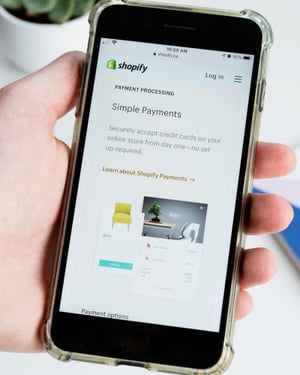From major, national consumer brands shuttering stores to the news of Amazon profits during the 2020 coronavirus pandemic, brick and mortar brands face a difficult challenge today.
History has shown us that offering e-commerce options will help ease the struggles businesses face. Target embraced digital and took its offerings online to great success—Target Breaks Top 10 in US e-commerce Sales.
Target checks in at No. 8 as its e-commerce sales are projected to increase 24% to $8.34 billion in 2020, elevating its total share of the U.S. e-commerce market from 1.1% to 1.2%, eMarketer said. Since 2016, Target’s e-commerce sales have risen 171%.
The need to sell online isn’t new to the current marketplace. It’s been a train coming down the tracks for more than a decade. And it continues to grow. Since Book Stacks Unlimited launched as one of the first online book sellers in 1992 (pre-Amazon!), we’ve moved to buying via computers more and faster every year. In fact, growth projections estimate that by 2022, e-commerce revenues will exceed $638 billion in the U.S. alone.
And when you look at the world of e-commerce brands and technology solutions, you’ll see even more evidence that we love to conduct business online.
 The Shopify story is one example of many. Today, their platform Shopify hosts over 325,000 shops for individual sellers plus internet giants including Google and Tesla. The company generates over $20 million in revenue each month.
The Shopify story is one example of many. Today, their platform Shopify hosts over 325,000 shops for individual sellers plus internet giants including Google and Tesla. The company generates over $20 million in revenue each month.
Other e-commerce solutions include BigCommerce, Magento, WooCommerce and many others. It’s clear that brick and mortar businesses need to continue to move online. The market for platforms to sell online continues to grow.
So why is it any surprise that adding a digital presence, and therefore a digital marketing strategy, is critical to your success?
The question a lot of brick and mortar businesses—large and small—are asking right now is how can they pivot to e-commerce to survive? Plus there’s the question they may have thought of yet, and that’s “How can digital marketing help us thrive?”
Pivoting from Brick and Mortar to E-Commerce
Now that we’ve established The Why, let’s explore The How of pivoting from face-to-face to digital business.
Jenn’s Vintage Village
The Content Marketer for Impulse’s Inbound team, Jenn Villa, recently established her own vintage store, which she runs on the side when she’s not crafting blogs or websites for customers like you.
 Jenn’s shop, Villa Vintage, is one of many vendors in a collective space called Building Character, located in the city of Lancaster, PA. Like most businesses, this arts building was shut down during the COVID-19 pandemic, leaving Jenn without a storefront for many months.
Jenn’s shop, Villa Vintage, is one of many vendors in a collective space called Building Character, located in the city of Lancaster, PA. Like most businesses, this arts building was shut down during the COVID-19 pandemic, leaving Jenn without a storefront for many months.
This presented a challenge, as she only just created her brand and shop in late January of 2020— just weeks before mass business closures. While Jenn did have an Instagram account and Facebook Business page pre-quarantine, she credits her newfound digital focus as a direct result of the pandemic— more as a “need” vs. a “nice-to-have,” to put it in her words.
“When the pandemic hit hard and Building Character shut its doors, I knew I had to get scrappy— and get scrappy fast,” Jenn told us. “I basically did what I had to do to buckle down and breach the gap between storefront and online business.”
Jenn began by removing some of her inventory from the arts space and storing it in her living room closet, “It’s not glamorous,” she said, “But I needed it at my fingertips.”
Our Content Marketer leveraged the skills she picked up from her past degree in Broadcasting to set up space for photographing her inventory.
“I have a very small townhome and no spare room to operate out of. That didn’t matter. I cleared my record player stand and set up lights all around it to get a professional-looking setting.” Other than that, Jenn tells us that’s the extent of her equipment: two box lights. While she has a DSLR camera, she tells us it’s just too much of a hassle to upload to the computer and edit on the desktop.
“When you have dozens of pieces of inventory to photograph and post, it’s just easier to do it right on your phone. No fancy gear here, just the iPhone 10,” she continues, “It’s not like I have a permanent photography studio to get my shots either, so I have to be deliberate and set a few hours aside to shoot all my new stock at once, since my living room is literally in shambles while it’s happening.”
Jenn began posting one photo a day on her Instagram shortly after her state’s governor closed all storefronts. This was a slow posting pace, but it was enough to keep producing new content consistently while she waited for thrift locations to reopen.
In addition to her daily posting, Jenn shares that she spends a considerable amount of time searching for similar vintage brands and “making nice.”
“When it comes to social media, it’s not always about the content itself you post. It’s about your engagement and interaction with your platform’s community. I just started looking up popular vintage hashtags and commenting and liking posts. This is a constant networking priority for me: a daily practice that reminds me that if you want people to engage with your brand, you need to give that same engagement in return.”
Jenn’s been also taking a crack at eBay, listing a few of her items on this digital selling platform, though she says sales haven’t been great— yet.
“It’s hard to juggle multiple selling avenues at once. I like to think I put 85% of my effort into Instagram during the heat of the pandemic, and while I did share content on Facebook and eBay, I tried not to stretch myself too thin and take away from the quality of my content in trade-off for the quantity of exposure. I understand that there are different audiences using different platforms, but I decided to just take things one step at a time. ‘Let’s get the Instagram in a good place,’ I told myself, ‘then I’ll worry about the others.’”
When asked about how the transition is going, Jenn gave a big smile.
“Every brand is going to have different benchmarks for success. For me, it was a milestone to hit 100 followers on Insta. But you best believe I celebrated it, sharing a post reminding my shoppers that ‘comparison is the thief of joy’ and reminding users to ‘celebrate your own progress on your own journey.’”

“For me, success is necessarily getting a certain amount of business page views a week or hitting a certain number of likes on a post. It’s being out and talking to a stranger only to discover they bought something from this really cute vintage stand a few months back that just opened and— what?— it was Villa Vintage! Or meeting another fellow thrifter in the area who recognizes my brand and gushes about how much they love seeing my thrifts online. Community. It all comes back to the community for me— building connections and sharing once forgotten finds that other antique lovers are so thrilled to bring back into the light of day on their favorite shelf.”
Building Character has been open with adjusted COVID hours for the past few weeks, but Jenn tells us that her online engagement won’t really change, “I’ve created quite the momentum listing online now, and while I am back to selling in-store, I’ve discovered just how powerful it is to manage and balance both. I recommend any business strive towards the same mentality. In today’s modern age, you need an online presence.”
How to Sell Online—Basic Choices for E-commerce
How do you actually sell online? Today’s e-commerce professionals have a ton of options to make this happen. Here are four of the most popular.
Your Own E-Commerce Store
Building an e-commerce store from scratch is the most traditional option most people lean into. It takes some work to get all of the pieces together; it also gives you the most control.
With this option, you need to choose your domain (the website name) and secure your own website hosting. Then you need to actually design the layout, add products and fill it with content. Of course, you can hire a designer or developer to do some of this for you. Or you can buy a theme in HubSpot as a framework.
When you’re done, you’ll have your very own site that you can control every aspect of. You have the freedom to add new products, change content and fiddle with the back end functionality.
Hosted E-Commerce Platforms
Hosted e-commerce platforms differ from dedicated e-commerce sites because the majority of the work that goes into creating the site is already done for you. It’s essentially a SaaS offering that gives you all the functionality of your own e-commerce site but you have less control over the details.
Shopify, BigCommerce and Big Cartel are the most common solutions. Each platform allows you to quickly set up a storefront from a select set of options. You can even choose from themes and templates. They also give you instructions for adding products, photos and other content to the site.
Users won’t likely know the difference between this and a completely custom site you’ve built. The difference would be for you. If you have specific design or behind-the-scenes preferences, they might not be available. Plus for you, this type of site is often easier or less expensive to get up and running. But they usually charge monthly fees that may exceed basic hosting fees over time.
Marketplace Sites
Marketplace sites like Etsy, eBay and Amazon are where small businesses can sell their products alongside other sellers, kind of like a digital flea market.
On the back end, these work fairly similar to hosted e-commerce platforms. But there are usually fewer options for customization. Most of these sites also charge a listing fee or take a percentage of each sale.
The benefit to marketplace sites? They come with a built-in audience. Amazon gets nearly 59 million monthly unique visitors, eBay sees nearly 27 million and Etsy nets nearly 16 million.
These platforms are less personalized to your own products and branding. Also, your products will most likely show up in search results alongside your competition. This is why it’s so important to create attractive listings that set your products apart.
One way to use marketplace sites is to sell some items here while keeping your own dedicated site. It helps with SEO and branding, which we’ll cover below.
Social Media Platforms
Who isn’t on social media these days? At least four of five adults in the U.S. use at least one social media platform. So for businesses, it makes sense to meet customers where they already spend their time.
The options for selling products on social media vary by platform. Facebook, for example, allows page owners to set up storefronts right on their business page. Instagram also has a feature that lets users create shoppable posts. Basically, users just click on a post to see the products pictured, then they can follow the links to complete a purchase right within the app.
Much like marketplace sites, a built-in audience is the key benefit of this option. However, many of the people spending time on social media aren’t in the mindset of making purchases; they’re connecting with friends and family. That’s why it’s called social media. So you may have to do more work to convert buyers than you would on a dedicated e-commerce site where people are already looking for products.
How to Add Digital Marketing to the Mix
![]() Now that you’re inspired to add a digital aspect to your brick and mortar business plan, it’s time to spread your message online.
Now that you’re inspired to add a digital aspect to your brick and mortar business plan, it’s time to spread your message online.
Here are a couple of tactics to help you move quickly into a digital marketing strategy and set yourself up for online selling success.
Offer Value
Are you concerned with how people will find you online? There’s a ton of information on search engine optimization (SEO), but getting found takes more than technical SEO knowledge.
In fact, it really boils down to bringing value to your audience, your potential customers. The first place that comes into play is a blog. Does your website include a blog where you can publish helpful, relevant content?
Let’s start with a definition. A blog is a collection of valuable articles that people can find in search, or that your sales team can use to save time while emailing potential leads (a great “hack” for your sales team!).
At its core, your blog is a simple way to create content your ideal customer needs, opening the conversation with your ideal buyers. It also keeps your website fresh and growing with new pages every time you publish.
Blog posts need to speak to your customers’ pain points in your brand voice. They have to help, educate, inform or entertain. Or all four! Make sure you’re writing valuable information addressing the problems faced by the humans you want to reach.
Consider using video to add value and help your business get found online. Video marketing works in a few ways.
- YouTube is a search engine. Publishing videos with solid video SEO helps you get found.
- YouTube is social. By using comments to engage and add value, you build an engaged community.
- You can link to your website on video platforms. YouTube, Wistia and other video publishing platforms include areas for descriptions. Add links here to help viewers engage more deeply with your content.
- We love video. At least 85% of all internet users in the U.S. watch video content each month. Producing video means you’re reaching people with the media they want.
Start Conversations
Do you know how to start conversations and convert viewers into engaged leads?
![]() Your content could reach 500,000 people, but if none of them start a conversation with you or become a lead - or better yet a customer - then it’s all for nothing.
Your content could reach 500,000 people, but if none of them start a conversation with you or become a lead - or better yet a customer - then it’s all for nothing.
One quick way to ensure you’re preparing for conversions is to make sure your blog articles have a call to action to take the reader to the next step. Add conversion opportunities like in-line links, sidebar CTAs and even pop-up forms to help your audience connect deeper with you.
You’ll want to make sure you’re putting forms to work. They’re the digital way to start a conversation, so ask the right questions, use context in where they are in their need of your product or services and don’t ask too many questions.
We also suggest using sales and marketing chatbots. Sometimes a chatbot asking to help will set a website viewer at ease.
Want to be a conversational marketing ninja? Ask the right questions for who the user is and where in their buyer’s journey, not simply “Hey can I help?”
Understanding context is vital. High intent pages mean viewers want to engage deeper with you. Service pages, product pages, “about us” pages all signal high intent. Add bots or live chat here to encourage “buy now” or “set a meeting” type actions.
By putting some of these tips to work, you’re on your way to pivoting from a brick and mortar to a more digital focus of e-commerce. Then, you can lean into a digital marketing strategy with our free guide. Nomatter where you find yourself today, we’re here to help!






